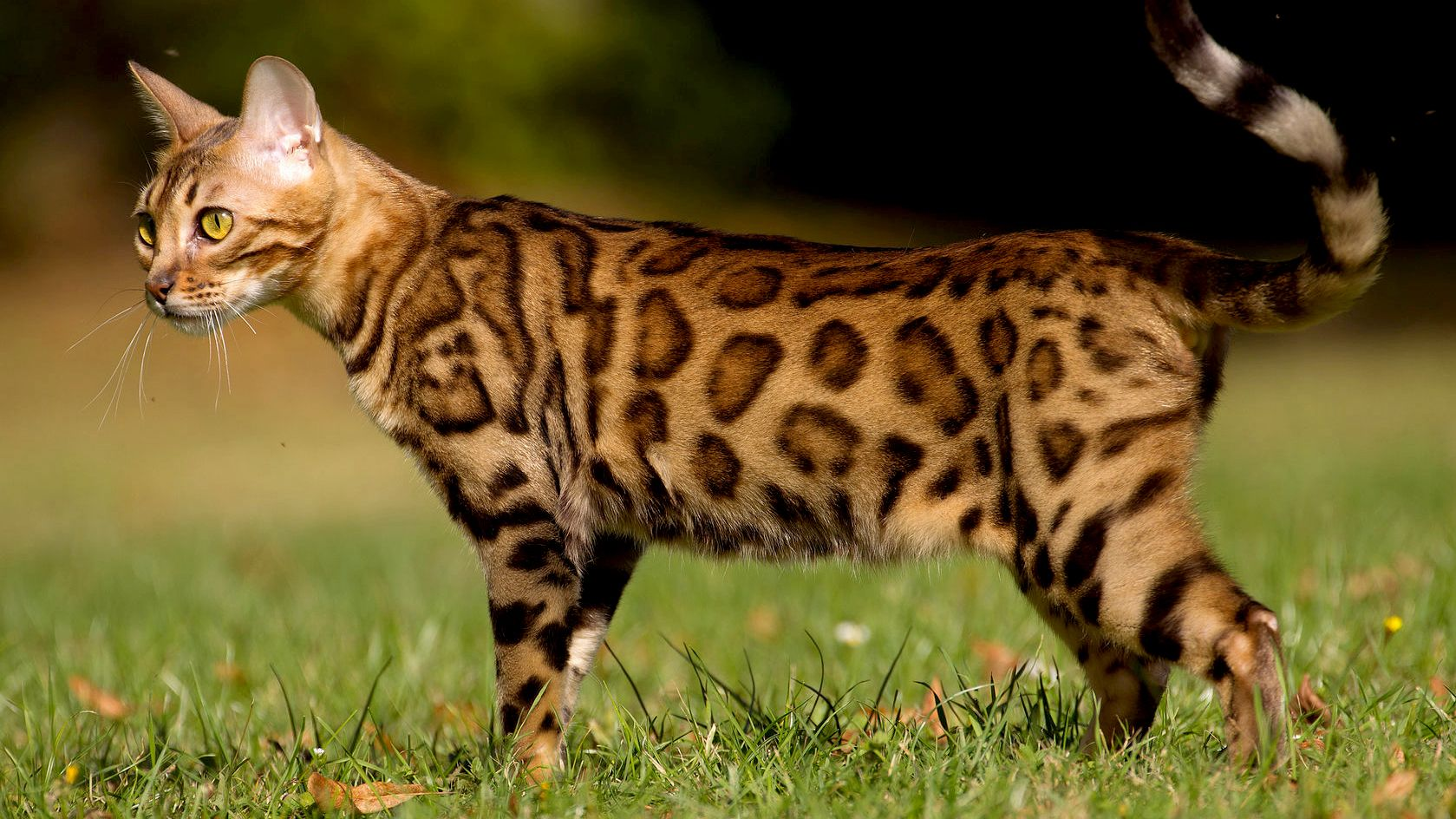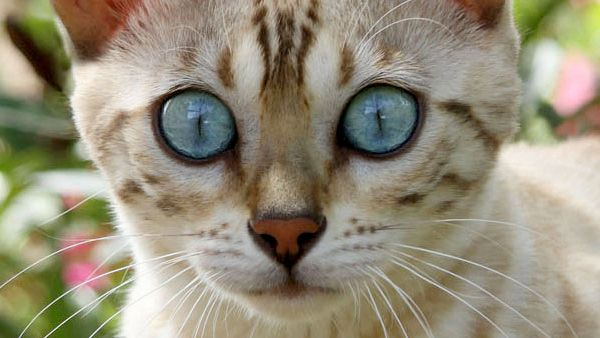Let's talk Bengals
The wild-like markings and stunning colours of the Bengal make this one cat that stands out from the feline pack. Their unique rosetted, or marbled, coat is just one of their intriguing characteristics, along with their confidence, huge curiosity, and non-stop energy. Independent as they may seem, the Bengal breed tends to get very attached to humankind, so look forward to loads of affection. Their development by a breeder in the early 1960s - by crossing a domestic tabby with a wild Asian Leopard Cat - explains the two sides of the intriguing Bengal personality, not to mention their untamed look.
Official name: Bengal
Other names: Leopard, Leo
Origins: United States of America
Hair length
1 out of 5Shedding Level
1 out of 5Grooming needs
2 out of 5Energy level*
4 out of 5Vocal
1 out of 5Family pet?*
5 out of 5Compatibility with other pets
4 out of 5Can be left alone
2 out of 5Environment (indoor/outdoor)
4 out of 5
| Male | Female |
|---|---|
| Height | Height |
| 20 - 25.5 cm | 20 - 25.5 cm |
| Weight | Weight |
| 10 - 15 lb | 8 - 12 lb |
| Life stages | |
|---|---|
| Kitten | Adult |
| 4 to 12 months | 1 to 7 years |
| Mature | Senior |
| 7 to 12 years | From 12 years |

Get to know the Bengal
All you need to know about the breed
If there’s one breed that embodies the moniker “curious cat,” it’s the Bengal. There’s a confidence within them, a desire to go out and explore their domestic surroundings, and with such a brilliant animal in your midst, it’s easy to let the adventure begin. Bengals have a fearlessness that’s fascinating to watch, and they don’t mind the audience.
The best part about having a Bengal cat around? Their fabulously unique rosette-shaped coat. The Bengal is the only breed that’s adorned with these uncommon graphics - shaped like those on their Leopard, Jaguar, and Ocelot cousins. The Snow Bengal is another variation of the breed, with its exceptional coloration that’s mostly white (think mini Snow Leopard). It’s a recessive colorpoint gene that makes for the white or light brown pattern, a very unique motif indeed.
The fur of the Bengal breed can also be marbled or speckled, with its plush thickness another signature trait; whatever the form, it’s incredible to behold.
If you value having a cat with off-the-charts energy, this is your breed. In fact, the Bengal is known to be kitten-ish even into their senior years. The unique cross-breeding of a domestic cat with one that calls the jungle home isn’t lost on this feline. They are unusually agile and athletic, very strong and yet graceful. For the highly desirable Bengal, words like magnificent, wondrous, and striking definitely apply.
The Bengal cat is known oddly enough for being very drawn to water, sometimes coming into the shower with family members or gazing upon water being run for cooking, bathing, brushing teeth, or even the mere washing of hands.

Two facts about Bengals
1. Circa 1963
One of the most recent breeds, the Bengal cat was only developed in 1963 and granted experimental status by the International Cat Association in 1983. the breed was then granted full status in 1991.
2. Teach them a trick or two
Don't think it's only dogs that can learn tricks. This very smart cat can, too. The Bengal can be taught sit, stay, paw, and even more complex tasks like fetch. They will be so good at them, you'll soon be wondering who is testing whom.
History of the breed
From head to tail
Physical characteristics of Bengals
1.Ears
2.Head
3.Body
4.Tail
5.Fur

Things to look out for
From specific breed traits to a general health overview, here are some interesting facts about your Bengal
Likes to climb - beware treasured chandeliers
With the jungle as their ancestral home, you can see why Bengals like to climb as high as possible—often to the highest point in the home. It’s a good idea to put away family heirlooms and expensive lighting, as well as keep a close eye on valued furniture. Their athleticism and fearlessness are among the amazing traits the Bengal has. The coolest part: Their very deft paws are able to accomplish a lot of complex tasks. The Bengal has been known to turn lightswitches on and off!
Guinea pigs of the world, unite!
As great a family pet as they can be, the Bengal breed has a high prey drive. Keep in mind that this is only the fourth generation since the breed came to be—four steps away from the wild, that is. When the breed became known (and more popular) in the late 1990s, potential owners had to get a license or permit to own a Bengal. The tendency to go after their own dinner still lingers. Steer the cat clear of small pets like gerbils, mice, or guinea pigs that may be kept in the same household just in case your cat gets any ideas. Know, too, that your Bengal has deft paws that can perform many tasks—like lifting tops and picking things up!
Bengals require a food with appropriate calories
As they are very active and high energy cats, they require a high quality complete and balanced diet that contains more calories than average cat foods. Feed the measured amount of food for the day, several times a day. Always watch the body condition of the Bengals and adjust the food amount based on their body condition score.
Tailored nutrition for Bengals

Tailored health nutrition has a fundamental role to play in maintaining the health and beauty of Bengal cats. Food provides energy to help with vital functions and a complete nutritional formula for Bengals should contain an adapted balance of nutrients. Feeding them in this way will offer a diet that's neither deficient nor excessive, both of which could have adverse effects on your cat's health.
The following recommendations are for healthy animals. If your cat has health problems, please consult your veterinarian who may recommend an exclusively veterinary diet.
Strong Immune System
Supports the development of the kitten's healthy immune system with the inclusion of clinically proven antioxidants, including vitamins E and C.
Healthy Growth
At 4 months old, a kitten's growth rate changes with rising energy levels to support growing bones and muscles. This formula contains an adapted level of protein, vitamins, and minerals for the final stage of kittenhood until 1 year old.
Microbiome Support
Combination of prebiotics and highly digestible proteins to help promote a healthy balance of intestinal microbiota for digestive health.

The main nutritional goals for adult Bengals are:
Digestive Health
The Bengal cat can have a sensitive digestive system. Highly digestible protein (L.I.P.), an optimal fiber content, and prebiotics work to promote a balanced intestinal flora to support healthy digestion.
*Protein selected for its very high digestibility.
Athletic Condition
Full of energy, healthy Bengals are well-muscled and have a sleek appearance that depicts their athleticism. An optimal ratio of a high level of protein and fat content helps maintain muscle mass.
Healthy Glossy Coat
A defining feature of the Bengal is their distinctive coat with striking patterns and a uniquely silky feel. Specific amino acids, vitamins, omega-3 and omega-6 fatty acids help maintain healthy skin and a shiny coat.
Special Bengal Jaw
This specially designed Y-shaped kibble, adapted to the Bengal cat's jaw, encourages chewing to help support oral hygiene.

A senior Bengal cat - one over the age of 12 - may sometimes have difficulties with absorption, too. To maintain the weight of the aging cat and minimize the risk of deficiency, they should be given an extremely digestible food filled with essential nutrients.
Weight Maintenance
In some senior cats, the level of activity reduces with age, which leads to weight gain. Aging Spayed/Neutered 12+ contains a moderate level of fat to help maintain an ideal body condition.
Healthy Aging Complex
An exclusive complex of antioxidants including lycopene and omega-3 fatty acids to support the body systems through the aging process.
Renal Health
Helps support healthy renal function with a moderate phosphorus level.
Enriched with L-Carnitine
L-Carnitine is involved in healthy fat metabolism

Caring for your Bengal
Grooming, training and exercise tips
Agility and strength are a given for the Bengal. A natural athlete, they’ll need space to roam indoors and out, and to follow their natural instincts as they explore the trees and bushes of their domestic domain. Keep an eye on them when outdoors so they don’t wander off, and so they’re safe from predators, traffic, or thieves, a risk for any feline.
Grooming the stunning coat of the Bengal cat will be a pleasure for anyone who enters the world of this dynamic breed. This is one cat that’s relatively easy to take care of - meaning they don’t mind it a bit. Brushing them once a week should be enough to keep the shedding in check, which is low. Clip their nails on a monthly basis for maintenance.
The Bengal cat excels at learning tricks, and is easier to train than many other breeds of cats. They are highly loyal to owners and pleased when part of a group. Extremely alert and attentive, they have even been known to open doors and cupboards with their hand-like paws!
7/7
All about Bengals
Not at all. The breed is super friendly and always up for playing or just snoozing by one’s side. The Bengal is also known to be great around the little ones. To note: Bengals do have a high prey drive, so keep them away from the family hamster.
Other breeds that might interest you
Read more on this topic
Like & share this page